1994 CHEVROLET SUBURBAN oil viscosity
[x] Cancel search: oil viscosityPage 73 of 385
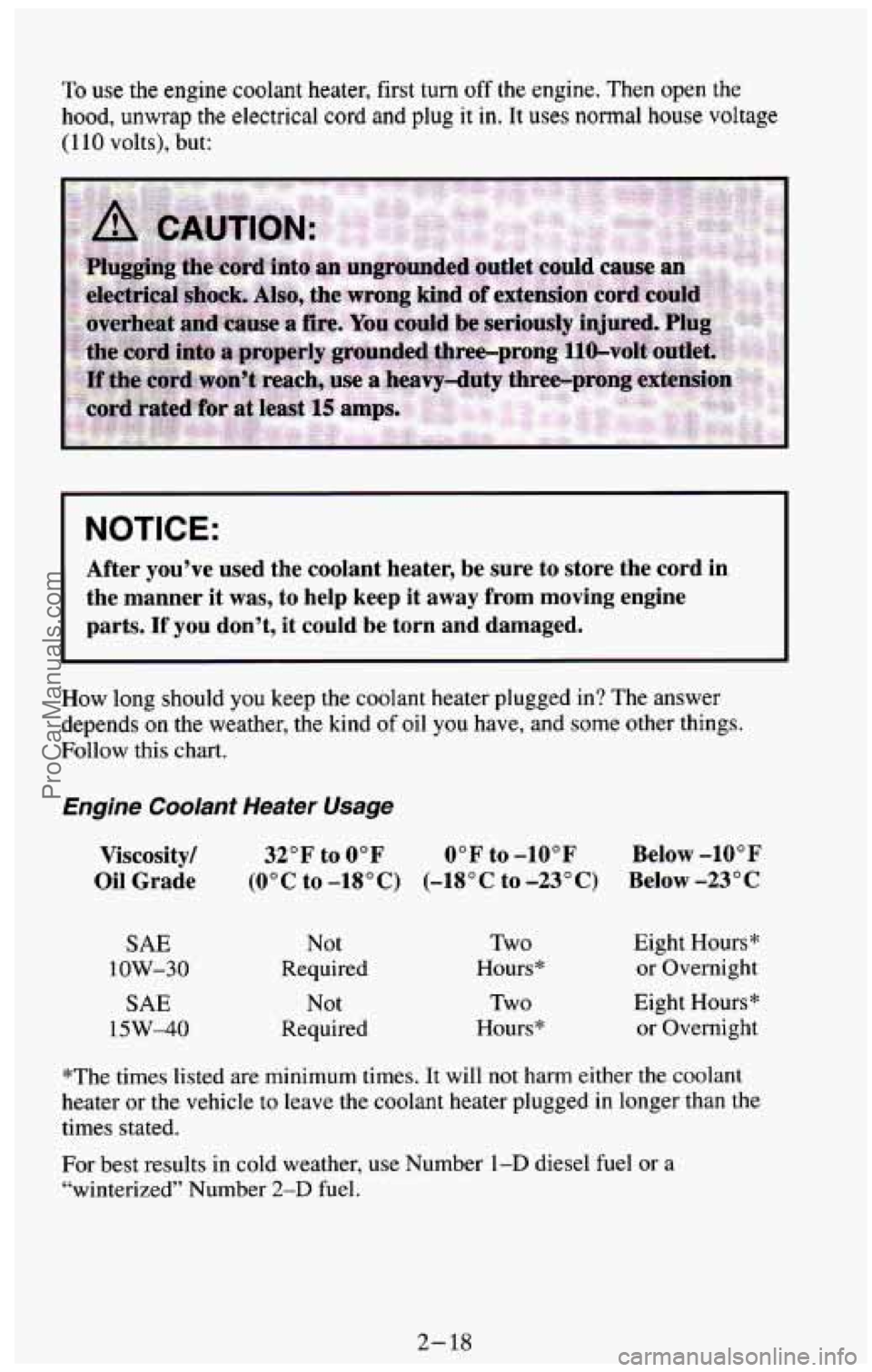
To use the engine coolant heater, first turn off the engine. Then open the
hood, unwrap the electrical cord and plug it in. It uses normal house voltage
(1 10 volts), but:
NOTICE:
After you’ve used the coolant heater, be sure to store the \
cord in
the manner it was, to help keep it away from moving engine
parts.
If you don’t, it could be torn and damaged.
How long should you keep the coolant heater plugged in? The answer
depends
on the weather, the kind of oil you have, and some other things.
Follow this chart.
Engine Coolant Heater Usage
Viscosity/
Oil Grade
SAE
1 OW-30
SAE
15W-40
32°F to 0°F 0°F to -10°F Below -10°F
(o0C to -18°C) (-18°C to-23°C) Below
-23°C
Not
Required
Not
Required Two
Hours*
Two
Hours* Eight Hours*
or Overnight
Eight Hours* or Overnight
*The times listed are minimum times.
It will not harm either the coolant
heater or the vehicle to leave the coolant heater plugged
in longer than the
times stated.
For best results
in cold weather, use Number 1-D diesel fuel or a
“winterized” Number
2-D fuel.
2-18
ProCarManuals.com
Page 129 of 385
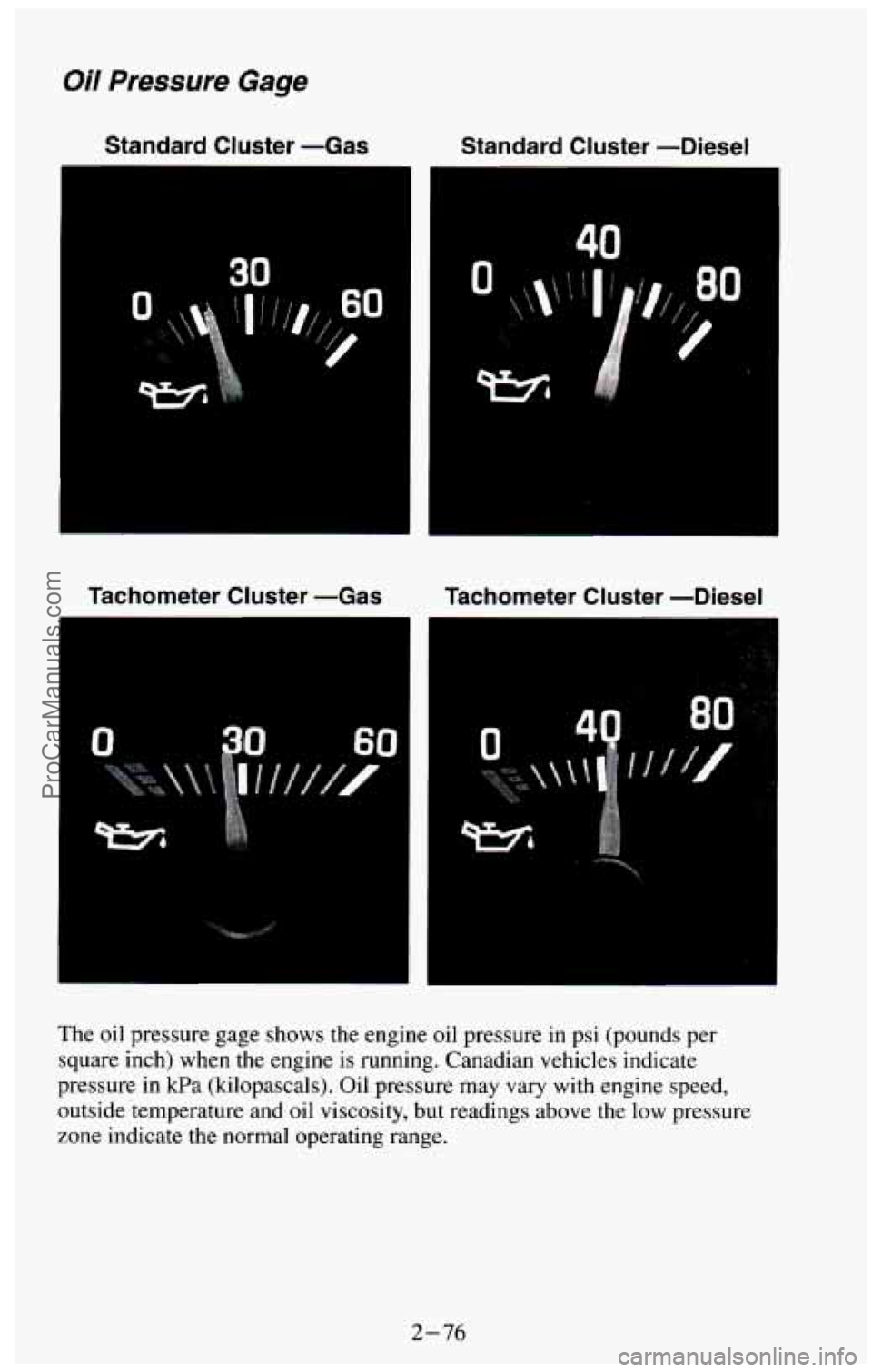
Oil Pressure Gage
Standard Cluster -Gas Standard Cluster -Diesel
40
Tachometer Cluster -Gas Tachometer Cluster -Diesel
The oil pressure gage shows the engine oil pressure in psi (pounds per
square inch) when the engine is running. Canadian vehicles indicate
pressure in
kPa (kilopascals). Oil pressure may vary with engine speed,
outside temperature and oil viscosity,
but readings above the low pressure
zone indicate the normal operating range.
2-76
ProCarManuals.com
Page 263 of 385
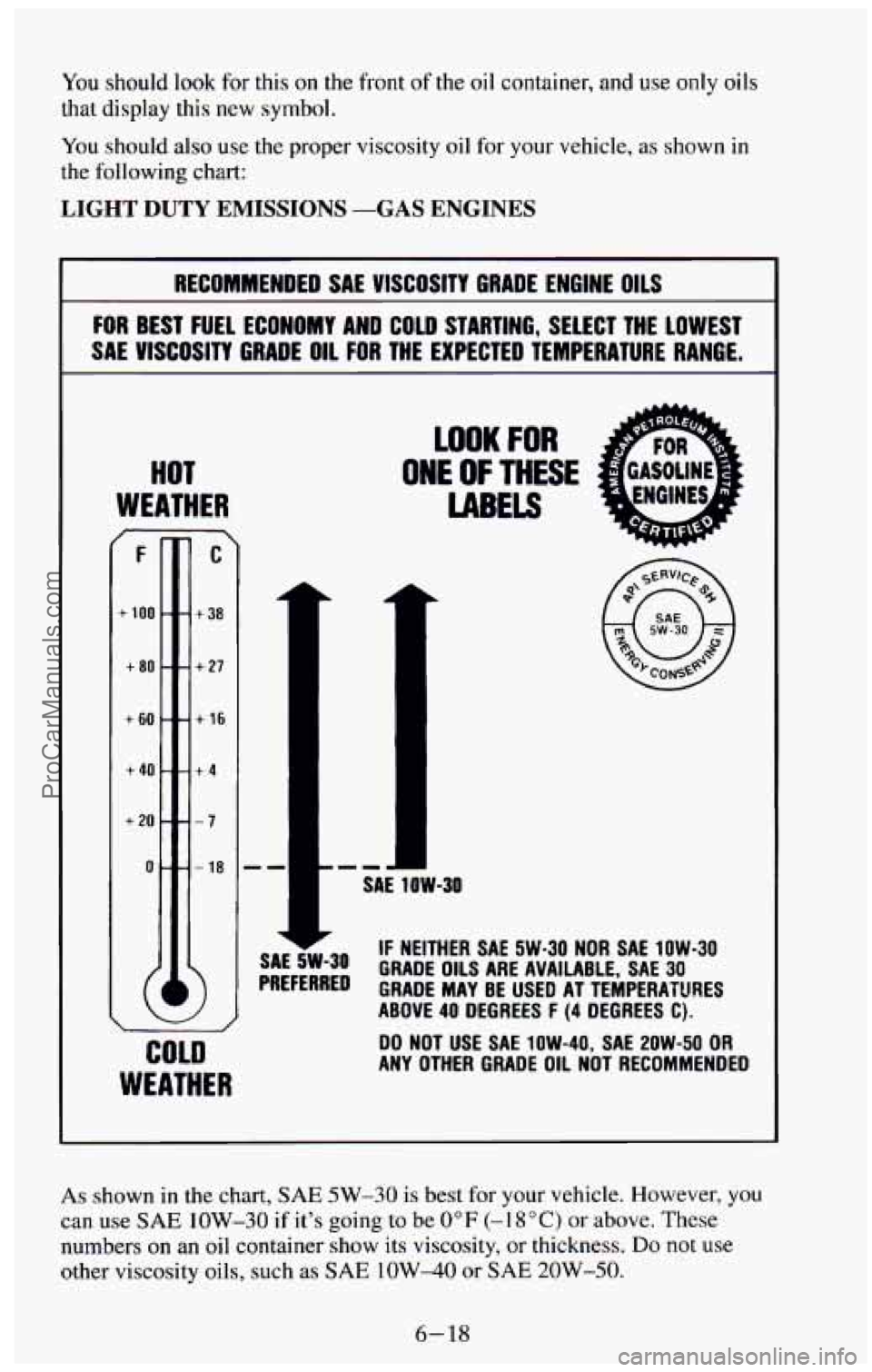
You should look for this on the front of the oil container, and use only oils
that display this new symbol.
You should also use the proper viscosity oil for your vehicle, as shown in
the following chart:
LIGHT DUTY EMISSIONS -GAS ENGINES
RECOMMENDED SAE VISCOSITY GRADE ENGINE OILS
FOR BEST FUEL ECONOMY AND COLD STARTING, SELECT THE LOWEST
SAL VISCOSITY GRADE OIL FOR THE EXPECTED TEMPERATURE RANGE.
HOT
WEATHER
F
+ 100 '
+80.
+60
+4a.
+20 -
0-
C
- +38
. +27
-+16
.+4
'-7
- 18
I
SAE SW-30
PREFERRED
LOOK FOR
ONE OF THESE
LABELS
SAE 1OW-30
IF NEITHER SAE 5W-30 NOR SAE 1OW-30
GRADE
OILS ARE AVAILABLE, SAE 30
GRADE MAY BE USED AT TEMPERATURES
ABOVE
40 DEGREES F (4 DEGREES C).
DO NOT USE SAE 1OW-40, SAE 2OW-50 OR
ANY OTHER GRADE OIL NOT RECOMMENDED
As shown in the chart, SAE 5W-30 is best for your vehicle. However, you
can use SAE 1OW-30 if it's going to be 0°F (- 1 8 O C) or above. These
numbers on
an oil container show its viscosity, or thickness. Do not use
other viscosity oils, such as SAE 1OW-40 or SAE 20W-50.
6-18
ProCarManuals.com
Page 264 of 385
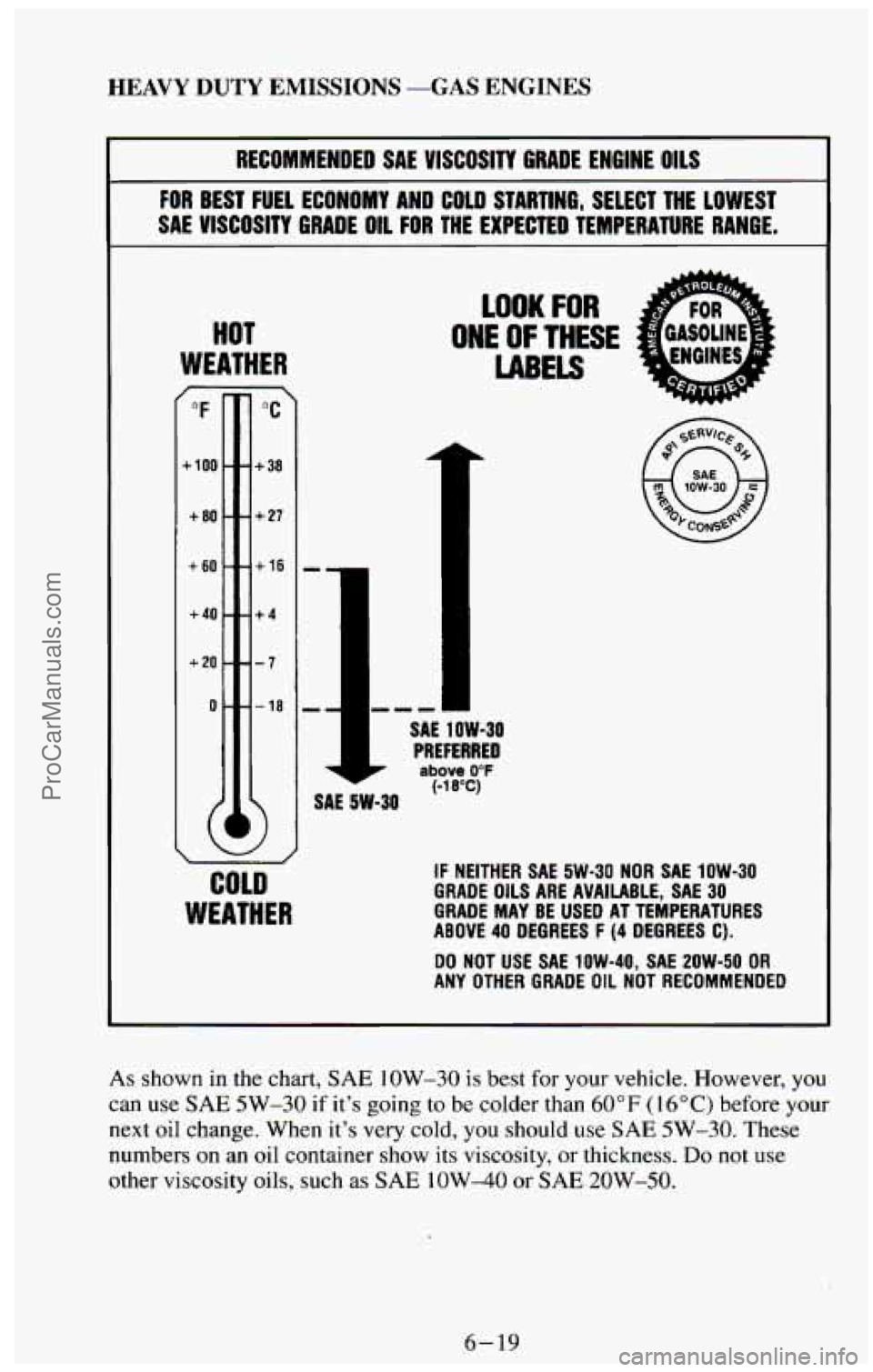
HEAVY DUTY EMISSIONS -GAS ENGINES
RECOMMENDED SAE VISCOSITY GRADE ENGINE OILS
FOR BEST FUEL ECONOMY AND COLD STARTING, SELECT THE LOWEST
SAE
VISCOSITY GRADE OIL FOR THE EXPECTED TEMPERATURE RANGE.
HOT
WEATHER
"F "C
+loo - - +38
+80 --+27
+60 - - +16
t40--+4
+20 ---I
0 - --18
LOOK FOR
ONE OF THESE
LABELS
I
I
SAE 1OW-30
PREFERRED
SAE
5W-30
COLD
WEATHER
IF NEITHER SAE 5W-30 NOR SAE 1OW-30
GRADE OILS ARE AVAILABLE, SAE 30
GRADE MAY BE USED AT TEMPERATURES
ABOVE
40 DEGREES F (4 DEGREES C).
ANY OTHER GRADE OIL NOT RECOMMENDED
DO
NOT USE SA€
1OW-40, SAE 2OW-50 OR
As shown in the chart, SAE IOW-30 is best for your vehicle. However, you
can use SAE 5W-30 if it's going to be colder than 60°F ( 16°C) before your
next oil change. When it's
very cold, you should use SAE 5W-30. These
numbers on
an oil container show its viscosity, or thickness. Do not use
other viscosity oils, such as SAE lOW-40 or SAE 20W-50,
6-19
ProCarManuals.com
Page 270 of 385
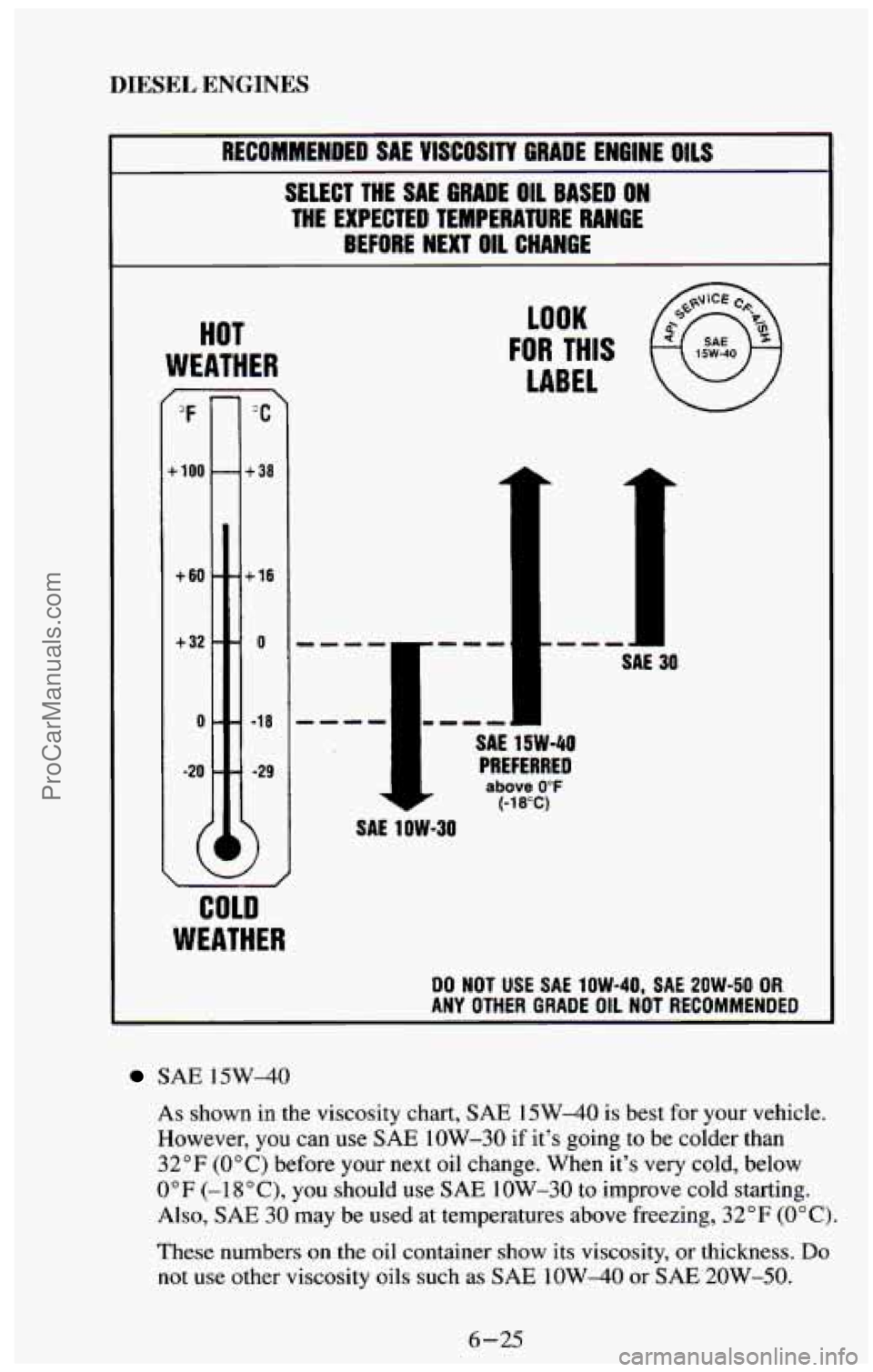
DIESEL ENGINES
I RECOMMENDED SAE VISCOSITY GRADE ENGINE OILS
SELECT THE SAE GRADE 011 BASED ON
THE EXPECTED TEMPERATURE RANGE
I BEFORE NEXT OIL CHANGE
HOT
WEATHER
+loo -
+60 - - +16
+32 -- 0
0 - - -18
-20 - - -29
________
COLD
WEATHER
LABEL
SAE 1OW-30
SAE 15W-40
PREFERRED
above 0°F (-18%)
- SAE r 30
DO NOT USE SAE 1DW-40, SAE 2OW-50 OR
ANY OTHER GRADE OIL NOT RECOMMENDED
SAE 15W-40
As shown in the viscosity chart, SAE 15 W-40 is best for your vehicle.
However, you can use
SAE low-30 if it’s going to be colder than
32°F (0°C) before your next oil change. When it’s very cold, below
0°F (-1 8”C), you should use SAE IOW-30 to improve cold starting.
Also, SAE 30 may be used at temperatures above freezing, 32°F (0°C).
These numbers on the oil container show its viscosity, or thickness. Do
not use other viscosity oils such as SAE 10W-40 or SAE 20W-50.
6-25
ProCarManuals.com
Page 351 of 385
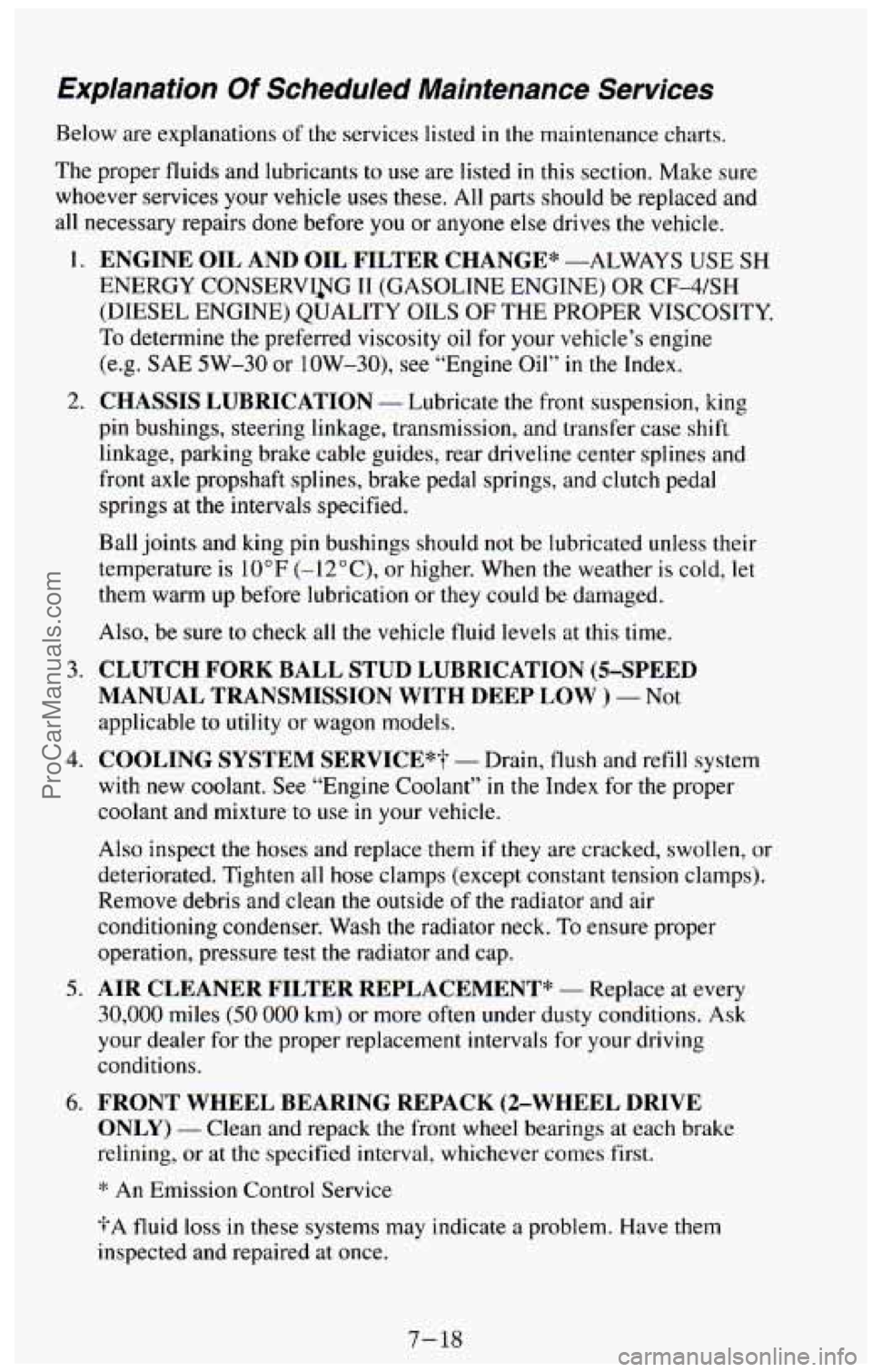
Explanation Of Scheduled Maintenance Services
Below are explanations of the services listed in the maintenance charts.
The proper fluids and lubricants to
use are listed in this section. Make sure
whoever services your vehicle uses these.
All parts should be replaced and
all necessary repairs done before you or anyone else drives the vehicle.
1. ENGINE OIL AND OIL FILTER CHANGE* -ALWAYS USE SH
ENERGY CONSERVIJTG TI (GASOLINE ENGINE) OR CF-4/SH
(DIESEL ENGINE) QUALITY OILS OF THE PROPER VISCOSITY.
To determine the preferred viscosity oil for your vehicle’s engine
(e.g.
SAE 5W-30 or low-30), see “Engine Oil” in the Index.
2. CHASSIS LUBRICATION - Lubricate the front suspension, king
pin bushings, steering linkage, transmission, and transfer case shift
linkage, parking brake cable guides, rear driveline center splines and
front axle propshaft splines, brake pedal springs, and clutch pedal
springs at the intervals specified.
Ball joints and king pin bushings should not be lubricated unless their
temperature is
10°F (-12”C), or higher. When the weather is cold, let
them warm up before lubrication or they could be damaged.
Also, be sure to check all the vehicle fluid levels at this time.
3. CLUTCH FORK BALL STUD LUBRICATION (5-SPEED
MANUAL TRANSMISSION
WITH DEEP LOW ) - Not
applicable to utility or wagon models.
4. COOLING SYSTEM SERVICE*? - Drain, flush and refill system
with new coolant. See “Engine Coolant’’
in the Index for the proper
coolant and mixture to use
in your vehicle.
Also inspect the hoses and replace them
if they are cracked, swollen, or
deteriorated. Tighten all
hose clamps (except constant tension clamps).
Remove debris and clean
the outside of the radiator and air
conditioning condenser. Wash the radiator
neck. To ensure proper
operation, pressure test the radiator and cap.
5. AIR CLEANER FILTER REPLACEMENT* - Replace at every
30,000 miles (50 000 km) or more often under dusty conditions. Ask
your dealer for the proper replacement intervals
for your driving
conditions.
6. FRONT WHEEL BEARING REPACK (2-WHEEL DRIVE
ONLY)
- Clean and repack the front wheel bearings at each brake
relining, or at the specified interval, whichever comes first.
4’ An Emission Control Service
*A fluid loss in these systems may indicate a problem. Have them
inspected and repaired at once.
7- 18
ProCarManuals.com
Page 358 of 385
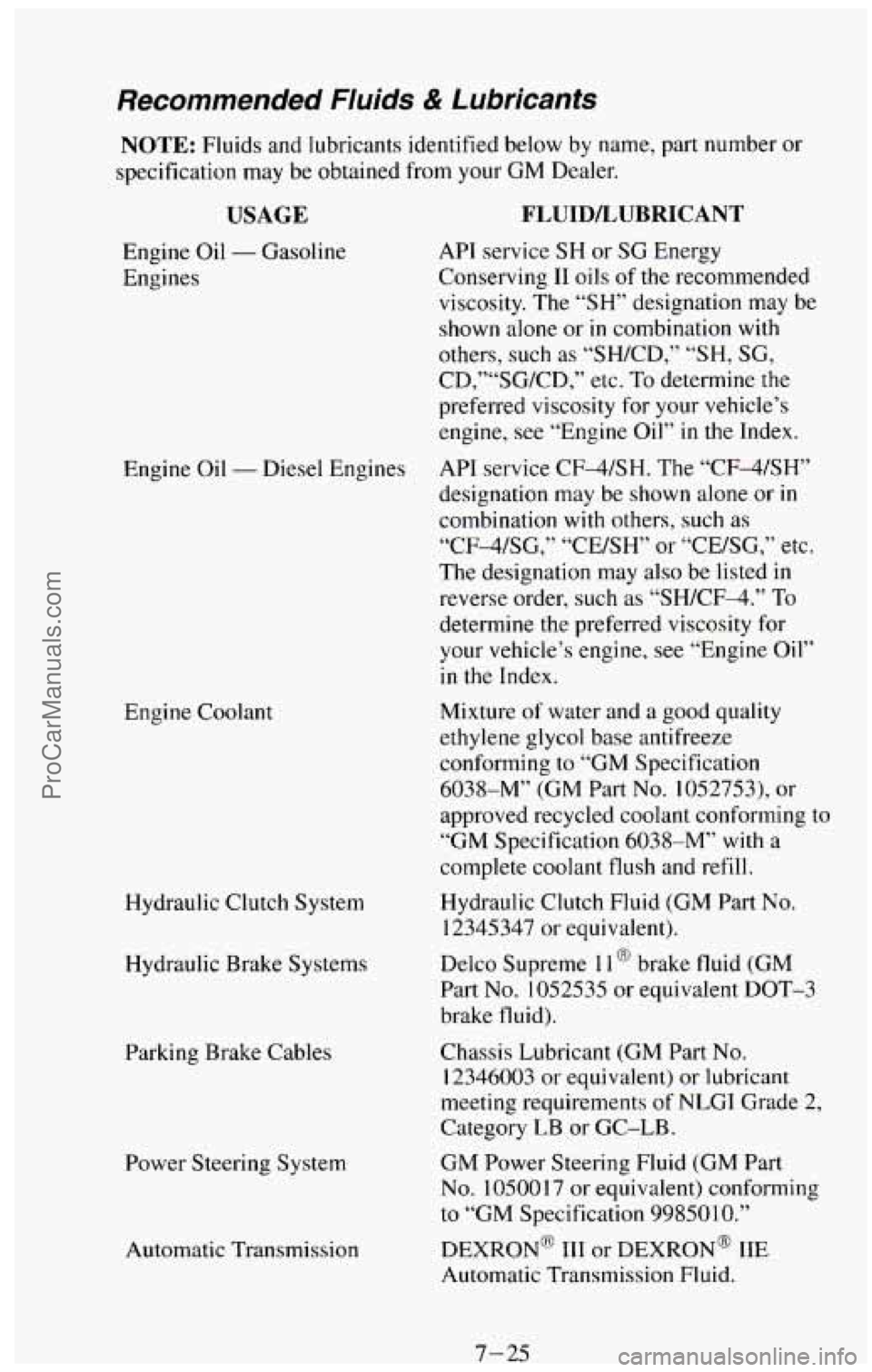
Recommended FIuids & Lubricants
NOTE: Fluids and lubricants identified below by name, part number or
specification may
be obtained from your GM Dealer.
USAGE
Engine Oil - Gasoline
Engines
Engine Oil
- Diesel Engines
Engine Coolant Hydraulic Clutch System
Hydraulic Brake Systems Parking Brake Cables
Power Steering System Automatic Transmission
FLUIDLUBRICANT
API service SH or SG Energy
Conserving
I1 oils of the recommended
viscosity. The
“SH” designation may be
shown alone or
in combination with
others, such as “SH/CD,”
“SH, SG,
CD,”“SG/CD,” etc. To determine the
preferred viscosity for your vehicle’s
engine, see “Engine Oil”
in the Index.
API service CF4SH. The “CF4SH”
designation may be shown alone or
in
combination with others, such as
“CF-4/SG,” “CE/SH” or “CE/SG,” etc.
The designation may also be listed
in
reverse order, such as “SH/CF-4.” To
determine the preferred viscosity for
your vehicle’s engine, see “Engine Oil”
in the Index.
Mixture
of water and a good quality
ethylene glycol base antifreeze
conforming to “GM Specification
6038-M” (GM Part
No. 1052753), or
approved recycled coolant conforming to
“GM Specification 6038-M” with a
complete coolant flush and refill.
Hydraulic Clutch Fluid
(GM Part No.
12345347 or equivalent).
Delco Supreme
11 @ brake fluid (GM
Part
No. 1052535 or equivalent DOT-3
brake fluid).
Chassis Lubricant (GM Part
No.
12346003 or equivalent) or lubricant
meeting requirements of
NLGI Grade 2,
Category LB or GC-LB.
GM
Power Steering Fluid (GM Part
No. 10500 17 or equivalent) conforming
to “GM Specification
99850 10.”
DEXRON~ TTI or DEXRON~ IIE
Automatic Transmission Fluid.
7-25 ProCarManuals.com